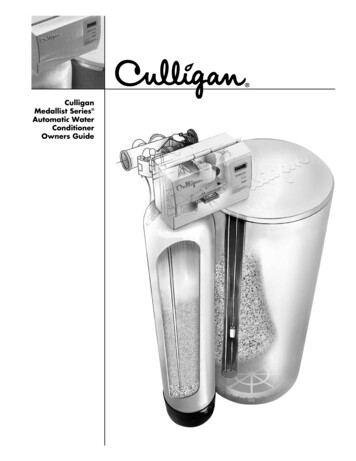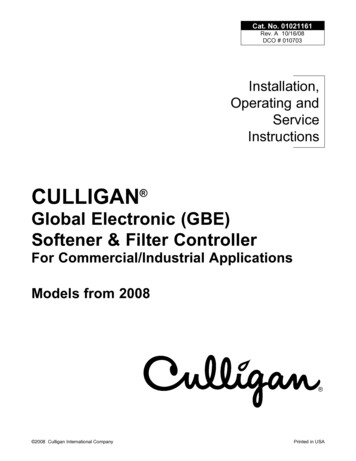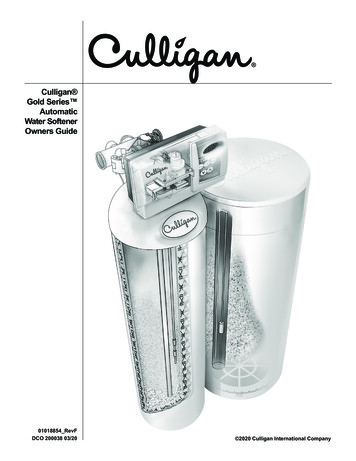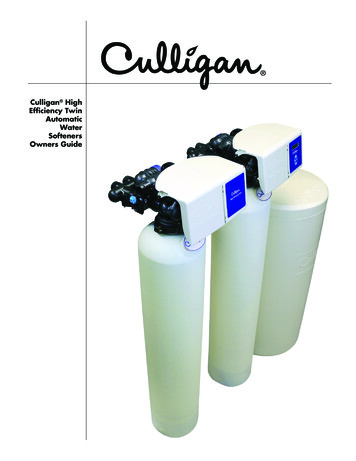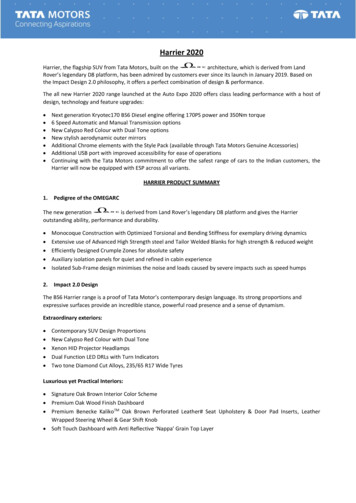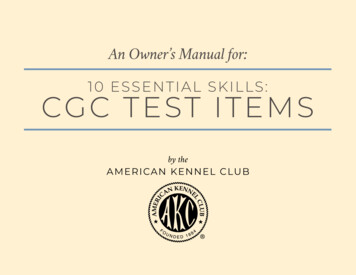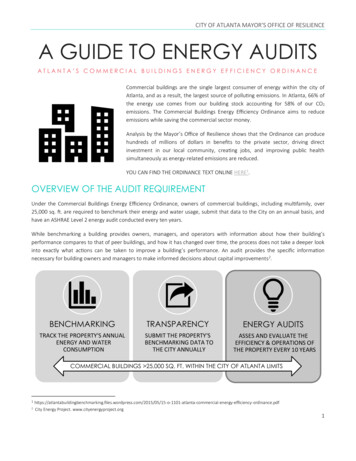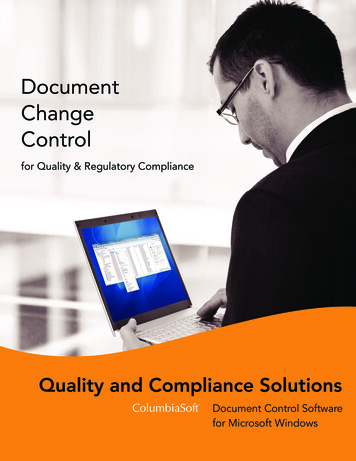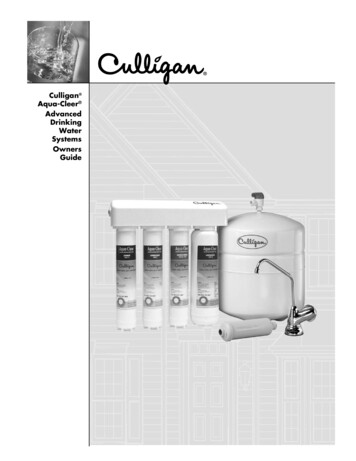
Transcription
Culligan Aqua-Cleer AdvancedDrinkingWaterSystemsOwnersGuide
THANK YOUAND WELCOME TO YOUR NEW WORLD OF BETTER LIVING WITHCULLIGAN WATER.Notice: Do not use with water that is microbiologically unsafe or of unknown quality withoutadequate disinfection before or after the system. Systems certified for cyst reduction may be usedon disinfected water that may contain filterable cysts.For installations in Massachusetts: Massachusetts Plumbing Code 248 CMR shall be adheredto. Consult your licensed plumber for installation of this system. The use of saddle valves isnot permitted in Massachusetts.Check with your public works department for applicable local plumbing and sanitation codes. Followyour local codes if they differ from the standards used in this manual.Operational, maintenance and replacement requirements are essential for this product to performproperly. Talk to you Culligan dealer about a service and maintenance program to ensure your filtersare replaced in a timely manner and annual water tests are also recommended (especially on wellwater) to ensure the system is functioning properly.Culligan International Company9399 West Higgins RoadRosemont, Il. 600181-800-Culliganwww.culligan.comProducts manufactured and marketed by Culligan International Company (Culligan) and its affiliatesare protected by patents issued or pending in the United States and other countries. Culliganreserves the right to change the specifications referred to in this literature at any time, without priornotice. Culligan, Aqua Cleer, and Culligan Man are trademarks of Culligan International Company orits affiliates.
About Your System . . . . . . . . . . . . . . . . . . . . . . . . . . . . . . . . . . . . . . . . . . . . . . . . . 4Installation . . . . . . . . . . . . . . . . . . . . . . . . . . . . . . . . . . . . . . . . . . . . . . . . . . . . . . . . 7How to Maintain Your System . . . . . . . . . . . . . . . . . . . . . . . . . . . . . . . . . . . . . . . 11Parts List . . . . . . . . . . . . . . . . . . . . . . . . . . . . . . . . . . . . . . . . . . . . . . . . . . . . . . . . 13Performance Data Sheet . . . . . . . . . . . . . . . . . . . . . . . . . . . . . . . . . . . . . . . . . . . 14Arsenic Fact Sheet . . . . . . . . . . . . . . . . . . . . . . . . . . . . . . . . . . . . . . . . . . . . . . . 23ATroubleshooting Guide . . . . . . . . . . . . . . . . . . . . . . . . . . . . . . . . . . . . . . . . . . . . . 25Service Log . . . . . . . . . . . . . . . . . . . . . . . . . . . . . . . . . . . . . . . . . . . . . . . . . . . . . . 27Warranty . . . . . . . . . . . . . . . . . . . . . . . . . . . . . . . . . . . . . . . . . . . . . . . . . . . . . . . . 28Table ofContents
AboutChapterYourHeadingSystemThank you for choosing a Culligan Aqua-Cleer advanced drinking water system. Your newsystem is designed to bring you years of deliciously crystal-clear Culligan water. The bestpart is it comes right from the tap. No more lugging around bottles or waiting for pitchersto slowly fill up. With your continuous supply of great tasting water, not only can you getyour 8 glasses a day but you can easily use it for cooking, coffee, juice, baby formula, icecubes, anything you use water with.The important thing to remember is to change out your filters on a regular basis. Thequality of your water is only as good as the quality of your filters. Each filter is designedto last for 500 gallons (roughly 6 months). Membranes will last longer if used with prefiltration. A flow monitor is available with your system to let you know when you haveconsumed 500 gallons of water through your system. If you did not purchase one with yoursystem, you may consider asking your Culligan man about having one installed. Faucetswith reminder lights are also available.System Specifications:Filter AssemblyStandard Storage TankMedium Storage TankLarge Storage Tank13.8” wide x 4.2” deep x 15.5” high9” diameter x 14” high11” diameter x 14” high15.5: diameter x 24” highStorage TankCapacityStandardMediumLarge2 gallons3 gallons9 gallonsReverse OsmosisEfficiency RatingStandardMediumLarge16.86%16.86%16.86%Reverse OsmosisRecovery onsFiltration Options:Sequence of FiltrationType of FiltrationSpecificationSediment5 micron10 micron25 micronCarbonBlockGranulated Active CarbonPre-FiltrationReverse Osmosis30 gpd50 gpdNano Filtration30 gpdMembrane
Sequence of FiltrationType of FiltrationSpecificationAdvanced FiltrationTotal DefenseArsenicPerchlorateSpeciality Carbon BlockSpecialty MediaSpecialty MediaPost-FiltrationCarbonGranulated Activated CarbonBlockAbout YourSystem (con’t)Purpose of each level of filtration:Pre-Filtration:Pre-filtration for this system is used to remove large contaminants from the water beforethey reach either the reverse osmosis or nano filtration membrane. The use of pre-filtrationcartridges helps extent the membrane’s life. There are two types of pre-filtration availablewith this system: sediment filtration and carbon filtration.Sediment Filtration: Sediment is defined as sand, dirt, silt, fine sand and orcoarse sand that can be found in many water supplies.Carbon Filtration: Carbon is used to reduce chlorine taste and odor. Most peopleoften describe this taste as being slightly chemical or they equate their drinkingwater to that of the local pool. Municipalities use chlorine to disinfect the water onthe way to your home. This is a necessary step to delivering safe water to yourhome but depending on the level of chlorine by the time it reaches your home thetaste of your water may be unpalatable.Membrane Technologies:The Aqua-Cleer system can utilize two different membrane technologies; reverse osmosisand nano filtration. Each one of these technologies use a tightly woven membrane thatacts as a barrier to contaminants. Water is pushed up against this membrane at pressure.Depending on the weave of the membrane only a certain percentage of contaminants canpass through. Reverse Osmosis can reduce up to 99% of contaminants. The reason youmay choose nano filtration versus reverse osmosis is often a question of taste. Some ofthe things that give water its taste are minerals such as calcium and magnesium. A nanofiltration membrane will leave more of those minerals in the water.Advanced Filtration:The advanced filtration cartridges are specifically designed to reduce contaminants thatreverse osmosis membranes are not efficient in removing.Total Defense:The Total Defense cartridge should be added to your system to deal with lead, mercury,chloramines, aesthetic chlorine taste and odor, cysts, Volatile Organic Compounds (VOC)and MTBE.
About YourSystem (con’t) Chloramines have a stronger taste and are more difficult to remove thanchlorine.Mercury is a toxin that can cause kidney damage.Lead is a toxin that can cause kidney problems or high blood pressure inadults and developmental problems in children.Cysts are a common cause of health issues. They can be found in somemunicipal water sources but more often found in wells under the influenceof surface water.VOC is a name given to a wide range of organic contaminants, some areknown to be carcinogenic.MTBE was used in gasoline to reduce emissions and is consideredharmful.Perchlorate:Perchlorate is a by-product of munitions manufacturing (common in solid rocket fuel, roadflares, etc) that can be found in some water sources.Arsenic:Arsenic (As) is found naturally in some well water. Arsenic in water has no color, taste orodor. It must be measured by a lab test. Public water utilities must have their water testedfor arsenic. You can get the result from your water utility. If you have your own well, youcan have the water tested by an accredited lab. The local health department or the stateenvironmental health agency can provide a list of certified labs. Culligan Internationalis one such lab. For more information please contact your local Culligan dealer. Foradditional information about the arsenic in water can be found through the EPA’swebsite at www.epa.gov/safewater/arsenic.html.There are two forms of arsenic: pentavalent arsenic (As (V)) and trivalent arsenic(As (III)). Special sampling procedures are needed to a lab to determine what typeand how much of each type of arsenic is in the water. In well water, arsenic may bepentavalent, trivalent, or a combination of both. Reverse osmosis membranes are effectiveat reducing pentavalent arsenic but not trivalent arsenic. The Arsenic specific cartridge wasspecifically designed to reduce trivalent arsenic.
InstallationChapterHeadingAqua-Cleer FaucetMonitor SensorDrainDrain Linefrom Air Gapto Drain (3/8” Tubing)Cold Water SupplyDrain ConnectionFeedline 1/4” TubingMonitorPost Filter1/4” Drain Lineto Air Gap inFaucetBall ValveAqua-Cleer Manifold3/8” Tubing toFaucet Product PortTankTo Bottom Of RO CartridgeNote: Install the drain line so that it runs downward with no loops or low spots. Otherwise the unitwill overflow at the air gap siphon break built into the faucet, or make irritating gurgling sounds. The1/4” concentrate line that leads to the faucet should be installed in a straight vertical path to avoidmaking a gurgling noise.This owner’s guide provides visual assembly reference only. Since specializedskills are required in the assembly of the drinking water system, we recommendthat you contact your local independently operated Culligan dealer to complete thisinstallation.Select Component Installation LocationsDispenser FaucetThe Culligan faucet is designed to be mounted on the rear lip of the sink. It maybe installed in an existing sprayer attachment hole or in a hole drilled at the time ofinstallation. It may also be mounted to an adjacent counter top. It should be positionedso that water is dispensed over the sink. A minimum 1-1/4” diameter hole is required.When installing the Aqua-Cleer water quality monitor, refer to the installation instructionspackaged with the monitor. Make certain the TDS level and/or gallons setting correspondto the desired water supply.
Installation(con’t)Important considerations: Access to the bottom (under sink) of the faucet is required for attachment ofproduct water line. The faucet can be installed for left- or right-handed operation. There should be no under sink obstructions which would prevent smooth tubingruns to the drain connection, carbon post-filter, or RO module assembly.Filter System AssemblyThe filter system assembly is designed to be mounted on any rigid vertical surface suchas a cabinet sidewall, sheetrock or exposed stud. It should be positioned such that thereis access to an inlet water source and drain. The installation should also allow convenientaccess for servicing.Inlet Water Supply ConnectionOnce a location is chosen for installation of the filter system assembly, select a nearbycold water line to provide the water source for the system. For under sink installations, thecold water faucet line can usually be tapped.The Reservoir TankPosition the reservoir tank near the faucet for optimum customer convenience. Thestandard and medium reservoir tank will weigh about 28 pounds (13 kg) when full of water,so it must be positioned on a stand or held securely by the optional mounting bracket.The reservoir operates best in the vertical position, but it will operate on its side. However,air will not escape readily and foaming may occur at the faucet nozzle. This should beexplained to the customer prior to installation.Drain ConnectionThe most convenient entry to the drain is directly above the P-trap of the kitchen sink.However, the concentrate water from the system can be connected to adjacent sinks ora floor drain. Extra care should be taken when entering drains near dishwashers or foodwaste disposals as back flow may occur through the air gap and cause flooding. Seeplumbing diagram on page 7 for proper air gap installation to waste connection.Installation of Filter System AssemblyThe mounting bracket contains three mounting slots. The holes are sized to accept #10round head wood screws (not supplied). Some types of surfaces such as particle boardor drywall may require the use of plastic screwanchors or toggle bolts to provide adequatesupport for the unit. Install Filter Cartridges1. Lightly lubricate the cartridge O-ring withsilicone lube and insert the sediment filtercartridge into the manifold.2. Twist the cartridge to lock it into the manifold.See Figure 2.LockedPositionUnlockedPositionFigure 2
3. Repeat steps 1-3 and install the flushed activated carbon filter cartridge into housingand the RO membrane element. Be sure the drain adapter is in place.Installation(con’t)Note:1) The RO cartridge must beinserted into the 2nd, 3rd, or 4thposition on the RO manifold.2) If only three cartridges are tobe inserted into the manifold, thebypass plug cartridge must beinserted in the 4th position. SeeFigure 3.Factors Which AffectPerformancePerformance of the reverse osmosismembrane is affected by severalfactors which must be consideredwhen judging the condition of thesystem. The main factors which affectsystem performance are pressure,temperature, total dissolved solidslevel, recovery and pH.Figure 3PressureWater pressure affects both the quantity and quality of the water produced by the ROmembrane. Generally, the more water pressure, the better the performance of the system.Be careful not to exceed 120 psi, the maximum operating pressure of the Aqua-Cleersystem.TemperatureThe reverse osmosis process slows with decreasing temperature. To compensate,a temperature correction factor is used to adjust the actual performance of the ROmembrane filter to the standard temperature of 77 F (25 C). This allows the performanceof the unit to be accurately gauged against Culligan’s published standards. Temperaturedoes not affect the concentrate flow rate.Total Dissolved SolidsThe minimum driving force which is necessary to stop or reverse the natural osmosisprocess is termed osmotic pressure. As the total dissolved solids level of the feed waterincreases, the amount of osmotic pressure increases and acts as back pressure againstthe reverse osmosis process. Osmotic pressure becomes significant at TDS levels above500 mg/L (ppm).HardnessHardness is the most common membrane foulant. If ignored, this relatively harmless
Installation(con’t)component of feed water will plug a membrane over time. Use of a softener will reducethe fouling effect on a membrane. One way to detect too much hardness in the feed wateris the weight of a membrane installed for a period of time. A fouled membrane (dried)will weigh significantly more than a new membrane. The increase in weight is a result ofprecipitated hardness inside the membrane.IronIron is another common membrane foulant. There are a variety of types of iron, someof which cannot be removed by an iron filter. Clear water iron can be removed moreeffectively by a softener. Particulate iron can be removed more effectively by a 1 micronfilter. Organic-bound iron can be removed only by activated carbon or macroporous anionresin. If there is enough iron to exceed the EPA secondary drinking water standard andsoftening the water is not an option and the iron is soluble, then an iron filter is appropriate.If none of these are an option then regular replacement of membranes will have tobe accepted.Product Water RecoveryProduct water recovery plays an important role in determining membrane and systemperformance. Recovery refers to the amount of water produced in relation to the amount ofwater sent to drain. The standard calculation is:% Recovery Product Water (Product Water Waste Water) x 100The Aqua-Cleer uses a flow control assembly to restrict the flow of waste water to thedrain. This restriction helps maintain pressure against the membrane. The sizing of theflow control assembly determines the recovery rating of the system. The Aqua-Cleer ismanufactured with a recovery rating designed to be around 30% -40%. Depending ontemperature, pressure and tolerances the actual recovery value may be slightly differentfor each system.10
To keep the Aqua-Cleer system operating properly, it is necessary to change the filtersand sanitize the system periodically. Typically, this should be done on an annual basis.Service frequency may vary depending on local water conditions. High sediment, chlorine,turbidity, or hardness levels may require more frequent service. Use the following asa guide.How toChapterHeading YourMaintainSystemAs needed:Clean the faucet with a soft cloth, avoid abrasive cleanersIt is recommended that you do the following annually:1. Sanitize the System2. Replace: Sediment Filter Activated Carbon Filter Polishing Filter Any Advanced Filtration Cartridge3. Check: RO Membrane Flow control assembly TDS Reduction Performance Flow Rates (including air gap) Drain tubing for back-upNOTE:The activated carbon, reverse osmosis, and polishing filter cartridges must be conditionedas follows prior to installation into the Aqua-Cleer system. Your Culligan man will do theseimportant procedures at the time of purchase. Activated Carbon Cartridge - 10 minute flush to remove carbon dust RO Membrane - Minimum 24 hour flush to remove preservative solution Polishing Filter - 10 minute flush to remove carbon dustPerform the following steps in the order shown to sanitizeyour systemIt is recommended to have your local Culligan dealer perform the sanitization process.Your local Culligan man has been specifically trained to test the water quality andefficiency of the system in order to determine when the RO membrane should be replacedand ensure the system is working properly.11
How toMaintain YourSystem (con’t)Preliminary Steps:1. Check for any leaks that may exist from tubing connections or the faucet.2. Check for flow to the drain. If flowing, close tank shut-off so you can check auto shut-offoperation3. Test and record product TDS from faucet. Also observe if faucet stem is stiff to move.4. Test and record feed TDS, and then calculate rejection percentage.5. If rejection is acceptable - Shut off storage tank, remove tank supply tubing to collectand record product flow, and water temperature.6. Record feed pressure if needed by attaching a pressure gauge to feed line. Use therecorded feed pressure and water temperature to check product flow rate against thesupplied chart. Membrane okay? Low production could be the result of partially pluggedprefilters. If so retest after filters are changed.7. With feed line off begin draining tank.The Aqua-Cleer RO manifold assembly may be sanitized with 5-1/4% liquid chlorineunscented bleach.1. Shut off water supply then remove all filters. Put bypass plugs in ports 2, 3 and 4.2. Pour two tablespoons liquid chlorine bleach into the sanitizer cartridge and place inport 1.3. Turn on the water supply valve and the RO faucet to allow the system to fill withwater. Allow the water to flow through until the entire system for about 10 minutesor until the sanitizing solution is through.4. Install new filters, including the post carbon filter, and membrane if needed, orreuse existing membrane. Some filters require flushing before use to remove dustand fines. If an in-plant flush was not performed, use the single head assembly toperform this using the feed line and drain lines available. Don’t flush using theRO manifold.5. Replace the battery in the quality monitor if applicable.6. Discard the first glass of water from the faucet.7. Thoroughly check for leaks.12
Parts ListChapterHeading691118103/8” Outlet1/4” Inlet75432ItemDescription1Manifold Assembly25 Micron Sediment Filter10 Micron Sediment Filter25 Micron Sediment Filter3Carbon Block FilterGranular Activated Carbon Filter430 GPD Reverse Osmosis Membrane50 GPD Reverse Osmosis MembraneNanofiltration Reverse Osmosis Membrane5Arsenic FilterPerchlorate FilterCarbon Block Filter (MTBE, VOC)Purifier CartridgeHealthy Cartridge (Add Calcium & Magnesium back into water for better taste)6Post Carbon Filter7Flow Control8Automatic Shut-off Valve9Faucet102 Gallon Storage Tank3 Gallon Storage Tank9 Gallon Storage Tank11*Ball ValveMonitor (Not Shown)13
PerformanceChapterDataHeadingSheetImportant Notice: Read this Performance Data Sheet and compare the capabilitiesof this system with your actual water treatment needs. It is recommended that, beforeinstalling a water treatment system, you have your water supply tested to determine youractual water treatment needs.Culligan knows the more informed you are about your water treatment systems, the moreconfident you will be about its performance. It’s because of this and more than seventyyears of commitment to customer satisfaction that Culligan is providing this PerformanceData Sheet to its customers.Company: Culligan International Company9399 West Higgins Road, Suite 1100Rosemont, IL 60018 USA(847) 430-2800Product:Culligan Aqua-Cleer Advanced Drinking Water SystemsUse Guidelines: Working Pressure: 40 – 120 psig (280-827 kPa) Do not allow exposure to temperature below 33 F (1 C) Maximum operating temperature: 100 F (38 C) These systems must be installed according to local plumbing codes on the coldwater line. This system requires regular replacement of all filters to maintain proper operation.Depending on usage and influent water quality, the carbon and particulate filtersshould be changed at least annually and the reverse osmosis membrane shouldbe replaced every 3-5 years. Varying chlorine, sediment or TDS levels may affectreplacement frequency.CAUTION! Do not use with water that is microbiologically unsafeor of unknown quality without adequate disinfection before or afterthe system. Systems certified for cyst reduction may be used ondisinfected water that may contain filterable cysts.14
Substance RemovalCBThe CB has been tested according to NSF/ANSI 42 for the reduction of the substanceslisted below. The concentration of the indicated substances in the water entering thesystem was reduced to a concentration less than or equal to the permissible limit for waterleaving the system, as specified in NSF/ANSI ermissibleProduct ctionAverageReduction 50%97.4%97.4%PerformanceData Sheet(con’t)Standard 42Chlorine2.0 mg/L 10%Flow Rate 0.5 gpm (1.89 Lpm)Capacity 1000 gallons (3786 L)Testing was performed under standard laboratory conditions, actual performance may vary.GACThe GAC has been tested according to NSF/ANSI 42 for the reduction of the substanceslisted below. The concentration of the indicated substances in the water entering thesystem was reduced to a concentration less than or equal to the permissible limit for waterleaving the system, as specified in NSF/ANSI ermissibleProduct ctionAverageReduction 50%53.4%75.4%Standard 42Chlorine2.0 mg/L 10%Flow Rate 0.5 gpm (1.89 Lpm)Capacity 1000 gallons (3786 L)Testing was performed under standard laboratory conditions, actual performance may vary.15
PerformanceData Sheet(con’t)Total Defense (TD)The Total Defense has been tested according to NSF/ANSI 42 and 53 for the reduction ofthe substances listed below. The concentration of the indicated substances in the waterentering the system was reduced to a concentration less than or equal to the permissiblelimit for water leaving the system, as specified in NSF/ANSI 42 and ermissibleProduct ctionAverageReduction 9.99%Standard 42Chlorine2.0 mg/L 10%Chloramines3.0 mg/L 10%Particulate(0.5 - um)Class IAt least 10,000particles/mL0.5 mg/L 85%Standard 53MTBE0.015 20%CystMinimum50,000/Lt0.005 mg/L99.95%Turbidity11 mg/L 1NTU0.5 NTU96.6%98.0%Lead(pH 6.5)0.015 mg/L 10%0.010 mg/L99.3%99.3%Lead(pH 8.5)0.015 mg/L 10%0.010 mg/L94.1%97.6%Mercury(pH 6.5)0.006 mg/L 10%0.002 mg/L96.7%96.7%Mercury(pH 8.5)0.006 mg/L 10%0.002 mg/L96.6%96.6%Chloroform (VOCsurrogatechemical)0.300 mg/L 10%0.015 mg/L99.8%99.8%Flow Rate 0.5 gpm (1.89 Lpm)Capacity 500 gallons (1893 L)tBased on the use of microspheres or Cryptospordium parvum oocystsTesting was performed under standard laboratory conditions, actual performance may vary.16
Organic Chemicals Included in Surrogate Testing:Applies to Total Defense (TD) only.SubstanceInfluent ChallengeConcentration mg/LMaximumpermissible product waterconcentration 10.001Carbofuran0.1900.001Carbon e benzene0.0880.001Ethylene Dibromide .000Heptachlor0.2500.000Heptachlor zine0.1200.004PerformanceData Sheet(con’t)Haloacetonitriles (Han):Haloketones (Hk):17
PerformanceData Sheet(con’t)Organic Chemicals Included in Surrogate Testing (Continued):Applies to Total Defense (TD) only.SubstanceInfluent ChallengeConcentration mg/LMaximumpermissible product waterconcentration 12,4,5-tp (Silvex)0.2700.002Tribromoacetic 0.001Trihalomethanes (Includes):Chloroform (Surrogate omethaneXylenes (Total)Substance RemovalNF30The NF30 has been tested according to NSF/ANSI 53 for the reduction of the substanceslisted below. The concentration of the indicated substances in the water entering thesystem was reduced to a concentration less than or equal to the permissible limit for waterleaving the system, as specified in NSF/ANSI sibleReductionMinimum AverageProduct WaterRequirements Reduction ReductionConcentration mg/LPentavalentArsenic pH 6.50.050 /- 10%0.01093.8%96.0%PentavalentArsenic pH 8.50.050 /- SubstanceStandard 5399.95%Testing was performed under standard laboratory conditions, actual performance may varytBased on the use of microspheres or Cryptosporidium parvum oocysts18
RO30This system has been tested according to NSF/ANSI 58 for the reduction of thesubstances listed below. The concentration of the indicated substances in water enteringthe system was reduced to a concentration less than or equal to the permissible limit forwater leaving the system, as specified in NSF/ANSI 58.PerformanceData Sheet(con’t)This system is acceptable for treatment of influent concentrations of no more than 27 mg/Lnitrate and 3 mg/L nitrite in combination measured as N and is certified for nitrate/nitritereduction only for water supplies with a pressure of 280 kPa (40 psig) or greater.Substance LMaximumPermissibleProductwater Concentrationmg/LArsenic (Pentavalent)20.050 /- 10%0.01Barium10.0 /- 10%293.8%Cadmium0.03 /- 10%0.00598.7%Hexavalent Chromium0.30 /- 10%0.0591.2%Trivalent Chromium0.30 /- 10%0.0594.8%Copper3.00 /- 10%1.398.9%Fluoride8.0 /- 10%1.595.6%Lead0.15 /- 10%0.010Nitrate/Nitrite (both as N)30 /- 10%Nitrate27.0 /- 10%3.0 /- 10%25pCi/L /- 10%5pCi/LSelenium0.10 /- 10%0.05Cyst4 50,000/mLTurbidity11 /- 1 NTU5NitriteRadium .9%84.7%80.0%96.0%99.95%0.5 NTU99.99%99.99%99.00%1 While testing was performed under standard laboratory conditions, actual performance ay vary depending on water pressure, temperatures andother substances, which may be found in your water.2 This system has been tested for the treatment of water containing pentavalent arsenic (also known as As(V), As( 5) or arsenate) at concentrationsof 0.050 mg/L or less. This system reduces pentavalent arsenic, but may not remove other forms of arsenic. This system is to be used on watersupplies containing a detectable free chlorine residual at the system inlet or on water supplies that have been demonstrated to contain only pentavalent arsenic. Treatment with chloramines (combined chlorine) is not sufficient to ensure complete conversion of trivalent arsenic to pentavalentarsenic. Please see the Arsenic Facts Sheet for further information.3 Based upon testing methods using Barium as a surrogate. All concentrations in pCi/L pico curie/L.4 Includes Giardia lamblia, Entamoeba histolyca and Cryptosporidium.5 Units are not certified on water supplies with a pressure less than 40 psi (280 kPa). A booster pump is strongly recommended.19
PerformanceData Sheet(con’t)InsideTextRO50This system has been tested according to NSF/ANSI 58 for the reduction of thesubstances listed below. The concentration of the indicated substances in water enteringthe system was reduced to a concentration less than or equal to the permissible limit forwater leaving the system, as specified in NSF/ANSI 58.This system is acceptable for treatment of influent concentrations of no more than 27 mg/Lnitrate and 3 mg/L nitrite in combination measured as N and is certified for nitrate/nitr
pass through. Reverse Osmosis can reduce up to 99% of contaminants. The reason you may choose nano filtration versus reverse osmosis is often a question of taste. Some of the things that give water its taste are minerals such as calcium and magnesium. A nano filtration membrane will leave more of those minerals in the water. Advanced Filtration:
